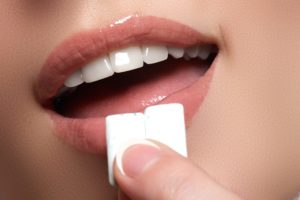Chewing Gum is a Rapid Test for Inflammation

Dental implants are reliable and long lasting replacements for missing teeth.
Dental implants are immune to tooth decay but a proportion of dental implant patients develop an inflammatory response around their implant years after implant placement.
The inflammatory response is called peri-implantitis and is very similar to gum (periodontal) disease around natural teeth. Bacteria left around the implant after tooth-brushing cause the imflammation and destroy the soft tissues and even the bone surrounding the implant.
Dentists and hygienists check for inflammation around teeth and implants at every check-up but, as the inflammation causes no symptoms, patients are at risk if they do not attend for checkups regularly.
A pharmaceutical research team in Germany has designed a chewing gum-based diagnostic test that will benefit patients by quickly and affordably assessing if they have the bacteria.
Where inflammation is suspected, chewing the gum will release a bitter agent. A dentist will then check to confirm the diagnosis and treat the condition.
The test provides numerous advantages including early detection to prevent serious complications. The test can be carried out anywhere by anyone, and doesn’t involve use of technical equipment.
How Does The Diagnostic Tool Work?
If there is inflammation in the mouth, the chewing gum will release a bitter agent. Inflammation causes the release and activation of specific protein-degrading enzymes that breakdown a special ingredient in the chewing gum.
Clinical studies have shown that the chewing gum test actually works. The diagnostic gum should be commercially available within two or three years.
The chewing gum testing method has other medical applications that are going through development phases.
Read the full story here




